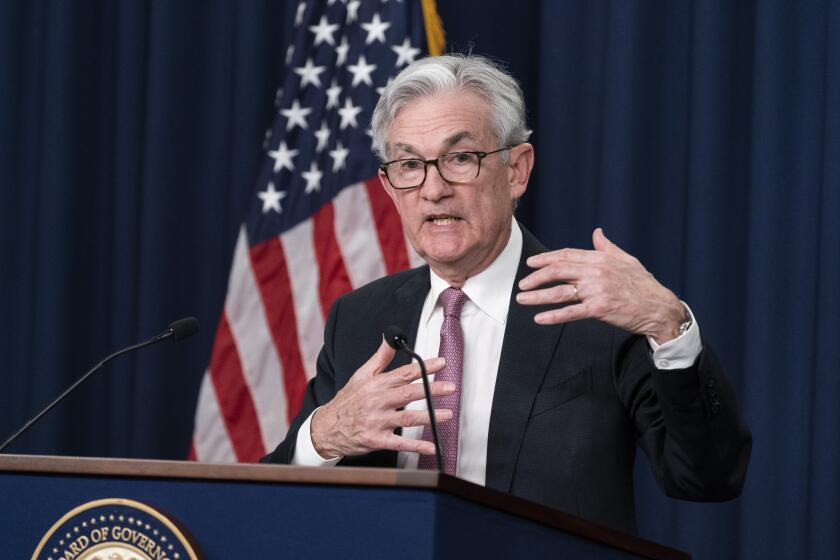Column: The big contributors to inflation you’re not hearing about: profiteering corporations

- Share via
Here’s an inflation remedy you’re not hearing much about: Reduce corporate profits.
If that sounds like a drastic, even radical idea, the reason may be that economic commentators and news pundits have been fixated on the role of higher wages in driving inflation higher.
As I reported recently, an argument is even being aired that the solution to inflation is to drive the unemployment rate higher.
Corporate markups are real. Bringing them down would be beneficial to the economy.
— Mike Konczal, Roosevelt Institute
What’s curious about that idea is that economic statistics make clear that corporate profits have played a much larger role in fueling inflation than wage increases or the currently low unemployment rate.
Wages have crept higher over the last year, but the increases have trailed inflation, which is why so many workers and their families are feeling the sting of higher prices. Corporate profit margins, however, have rocketed into the stratosphere, outpacing the inflation rate and pulling it higher.
Get the latest from Michael Hiltzik
Commentary on economics and more from a Pulitzer Prize winner.
You may occasionally receive promotional content from the Los Angeles Times.
“Markups and profits skyrocketed in 2021 to their highest recorded level since the 1950s,” Mike Konczal and Niko Lusiani of the Roosevelt Institute reported in a new paper. “Further, firms in the US increased their markups and profits in 2021 at the fastest annual pace since 1955.”
Despite that, worker-bashing remains the prevailing theme among inflation watchers. The latest example comes from the Wall Street Journal, which on Monday published an interview between its senior markets columnist, James Mackintosh, and former U.S. Treasury Secretary Lawrence Summers, an eminent inflation Cassandra.
In the course of what sounds like a toothsome “late-afternoon dish of cured salmon at a London hotel” (don’t ask why Mackintosh felt compelled to disclose the menu), they appeared to agree that “newly empowered workers” were among “the biggest forces pushing for higher long-term [interest] rates,” in Mackintosh’s words.
Taking steps to quell inflation by rolling back employment would cause unnecessary hardship for millions, with little gain to show for it.
The higher rates are “needed to keep prices under control,” Mackintosh explained to his readers. “Labor unions have formed in previously unassailable places, including sites of Amazon, Apple and Starbucks.... Stronger unions make for a more inflationary environment.”
A few things about that. First, if Mackintosh has evidence that stronger unions cause inflation, he should show his work, because in general terms there’s no evidence to support the premise. Rather, there’s evidence to the contrary.
In the 1950s, when as many as one-third of U.S. nonfarm workers were union members, annual inflation averaged about 2%. In the 1920s, another heyday for union membership, prices actually decreased; price spikes associated with the U.S. entry into World War I were played out by 1920).
The current spurt of high inflation, as it happens, has erupted while union membership in the private sector reached a dismal 6.1% in 2021. The number of rank-and-file workers represented by a union fell last year to 15.8 million, down by 137,000 from 2020.
The strikes and organizing actions that have been widely reported are encouraging signs for unionization, but still modest in the context of the overall decline of organized labor.
As for Amazon, Apple and Starbucks, which got a shout-out from Mackintosh, there are no signs that those companies are feeling any pinch from labor organizing activity, even though Amazon and Starbucks have conducted ferocious union-busting campaigns. Earlier this month, Apple employees in Towson, Md., won the first unionization vote at any of the company’s retail stores.
Amazon’s profit margin last year was 7.1%, up from 5.53% in 2020 and 4.14% in 2019. The margin at Starbucks was 14.4% in its last fiscal year, which ended Oct. 3. The company announced plans to return $20 billion to shareholders via dividends and stock buybacks over the succeeding three years.
David Weil would have enforced federal labor law leading the Labor Department’s Wage and Hour Division, so Republicans killed his nomination.
Apple has had a series of blowout results, including profit margins of better than 25% in its last full fiscal year, which ended Sept. 25, and its subsequent two quarters, through March 26.
In April, the company said it would increase its payouts to shareholders via a 5% increase in its dividend to 23 cents per share and an increase of $90 billion in its existing stock buyback program.
The story, in short, is: Don’t weep for these companies because they face unionization drives.
The bigger story is that the expansion of corporate profit margins has far outpaced wage gains over the last two years, including the period of surging inflation. From the first quarter of 2020 through the end of 2021, corporate labor costs increased by about 7%, but corporate after-tax profits by nearly 14%, according to the Bureau of Economic Analysis.
Konczal and Lusiani found that whereas average corporate markups, a fair proxy for profits, averaged about 26% above marginal costs from 1960 through 1980 and about 56% during the 2010s, they shot up to 72% in 2021.
“In other words,” they wrote, “in 2021, we see a sharp increase in ... firms in the aggregate decoupling their prices from their underlying costs.”
Higher markups “don’t necessarily have to translate to higher profits,” they added, “but they did in 2021.” Net profit margins, or profits divided by revenues, averaged 6% during the 2010s; in 2021 the figure jumped to 9.5%, “its highest value on record.”
Are inflation fears unreasonable? It depends on how you’re spending your money.
The authors acknowledge that the trend may have moderated in the last few months. “But corporate markups are real,” Konczal, the Roosevelt Institute’s director of macroeconomic analysis, told me.
“Bringing them down would be beneficial to the economy,” he says, “especially if you don’t think that profits will necessarily go to more investment but simply be paid out as bonuses to shareholders and bosses.”
Businesses certainly face genuine inflationary pressures. The most significant are related to the price of oil, either directly in the price of fuel or indirectly through prices for materials driven up themselves by higher energy prices. Supply chain constrictions have also contributed to higher prices for parts and raw materials.
But the higher profit margins indicate that businesses are raising prices more than would be necessary to cover their own higher costs.
At this point, businesses may sense they have the latitude to raise prices in part because consumers expect it, given the relentless reporting of inflation fears. (This is one way that inflation tends to feed on itself.)
Yet it’s possible that corporate profits will come down through a confluence of natural factors. Businesses might decide to absorb some wage increases and other costs, such as fuel, without passing them all on to consumers and tacking on additional vigorish.
There are signs that some of that may be happening: Retailers are preparing to cut prices to move outdated or excess merchandise out of warehouses and off the shop floor. Some consumer companies may sense greater resistance from customers if prices continue to stick at high levels, particularly if they see competitors undercutting them.
But as long as the narrative about the causes of inflation remains focused on wages and employment, policymakers may make the wrong choices about how to bring it down. “There is room for these margins to come down,” Konczal says. Federal Reserve Chairman Jerome H. Powell “doesn’t much talk about corporate profits and the ability of those margins and markups to decline and help take some of the pressure off.”
More to Read
Get the latest from Michael Hiltzik
Commentary on economics and more from a Pulitzer Prize winner.
You may occasionally receive promotional content from the Los Angeles Times.














